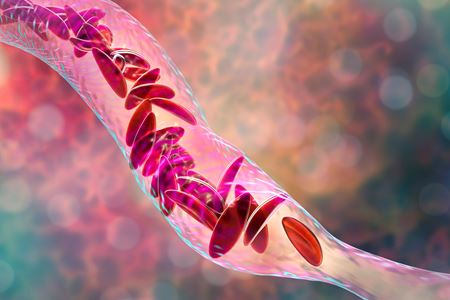INDIANAPOLIS—A new study led by Indiana University School of Medicine researchers found a brain network condition called “explosive synchronization” could be the cause of extreme pain crises in people with sickle cell disease.
“These findings could have a significant impact on patients with this disease,” said Ying Wang, MD, PhD, assistant professor of anesthesia, investigator at the Stark Neurosciences Research Institute and principal investigator of the study. “Unpredictable vaso-occlusive crises, known as pain crises, are extremely acute painful episodes, and the hallmark of sickle cell disease. With our research, we could soon be able to predict these episodes and provide interventions sooner for patients.”
Sickle cell disease is a rare genetic disorder that happens when a person’s red blood cells form a sickle “C” shape, rather than round. This causes the cells to die early, leading to a constant shortage of red blood cells, which are responsible for carrying oxygen throughout the body. As a result, people with the condition can experience severe pain and other serious complications.
 Researchers investigated the brain mechanisms of pain in patients with sickle cell disease by analyzing brain electroencephalogram (EEG) data. They identified a novel brain network condition called “explosive synchronization” and found significant correlations between the pain and the strength of explosive synchronization. The findings were recently published in Scientific Reports.
Researchers investigated the brain mechanisms of pain in patients with sickle cell disease by analyzing brain electroencephalogram (EEG) data. They identified a novel brain network condition called “explosive synchronization” and found significant correlations between the pain and the strength of explosive synchronization. The findings were recently published in Scientific Reports.
“This innovative finding is significant as it not only enhances our understanding of the pain mechanisms in sickle cell disease, but also potentially guides clinical diagnosis and the prognosis of pain management in these patients,” Wang said. “For example, early identification of an upcoming vaso-occlusive crisis might allow treatment to preempt a crisis.”
The team is now working on transforming these findings to a more portable, user-friendly EEG device that can be used by clinicians and individuals. They also hope to establish a multi-dimensional brain network model that will increase the ability to predict future pain crises.
“Our goal is to identify the temporal changes of the brain hypersensitivity network associated with the occurrence and progression of each pain crisis event,” Wang said. “We are also studying the effect of pain relief by treatments such as acupuncture, which may be able to reduce the occurrence and/or intensity of chronic pain and pain crises via mediating the strength of explosive synchronization and brain network hypersensitivity.”
Other study authors include Ziyue Liu and Andrew O’Brien of Indiana University; Pangyu Joo, Minkyung Kim, Uncheol Lee, Steven Harte of the University of Michigan; Richard Harris of the University of Michigan and University of California at Irvine; and Brianna Kish, Vidhya Vijayakrishnan Nair, and Yunjie Tong of Purdue University.
About IU School of Medicine
The IU School of Medicine is the largest medical school in the U.S. and is annually ranked among the top medical schools in the nation by U.S. News & World Report. The school offers high-quality medical education, access to leading medical research and rich campus life in nine Indiana cities, including rural and urban locations consistently recognized for livability. According to the Blue Ridge Institute for Medical Research, the IU School of Medicine ranks No. 13 in 2023 National Institutes of Health funding among all public medical schools in the country.




